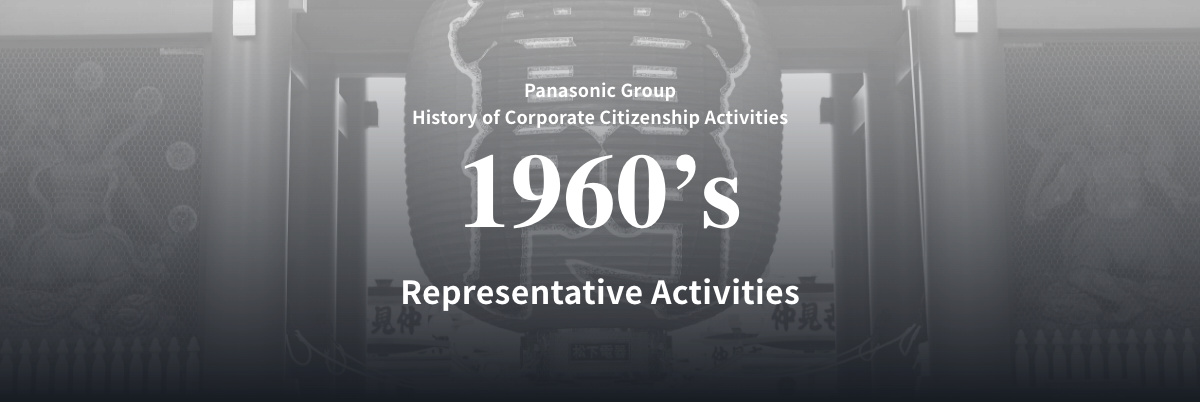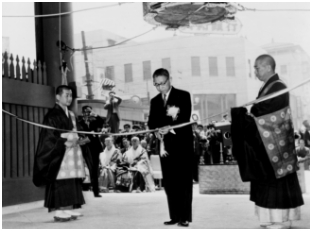

Construction/donation of the Kaminarimon Gate and large lantern at Kinryuzan Sensoji Temple
The Kaminarimon Gate of Sensoji Temple in Asakusa, Tokyo, which had long been a temporary structure put in place following a fire that destroyed the previous one back in 1865, was restored and donated in 1960, ending a 95-year-long absence. Additionally, the Kaminarimon lantern at the center of the gate was also dedicated to the temple, and in 1978 the two statues on either side were donated as well. In 1982, 1992, and 2003, when the large paper lantern that has become the symbol of Asakusa was severely damaged, it was restored and dedicated once more.
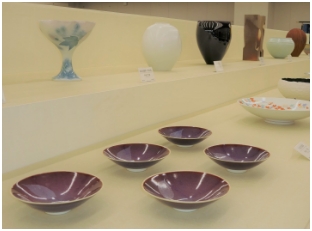

Support of the Japan Kogei Association
Our founder Konosuke Matsushita had a deep interest in traditional Japanese crafts, which can be seen as “the starting point of manufacturing”.
In 1960, he began his support of the Japan Kogei Association with the hope of passing on and further developing these crafts, and he also became the first head of the Kinki Branch. Since 1979, we have given the "Konosuke Matsushita Award" (later renamed the "Panasonic Award") to artists from the Kinki region who have either won or been newly selected at the Japan Traditional Kogei Exhibition. Starting in 2024, the award was renamed the "Konosuke Matsushita Memorial Panasonic Award," with some changes to its content. In addition to the traditional award given to newly selected artists from the Kinki region at the Japan Traditional Kogei Exhibition, we have established two new awards: the "Kinki Exhibition Newcomer Award" and the "Kinki Branch Achievement Award," to honor and celebrate the achievements and contributions of Kinki branch members.


Donation of the “Umeda New Pedestrian Bridge” in front of Osaka Station
In 1964, we built what was at the time the largest pedestrian bridge in Japan, spanning the wide road between the plaza in front of Osaka Station and both the Hankyu and Hanshin buildings, and donated it to the City of Osaka. Completion of this pedestrian bridge eased automobile congestion and allowed pedestrians to cross the street safely, and is still used by many people today.
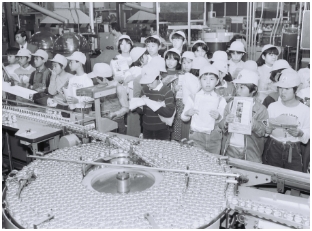

Began offering tours of our dry-cell battery plant (Moriguchi City, Osaka) for elementary and junior high school students
Around 1962, Matsushita Electric began a company-wide effort to encourage factories to offer tours, and was particularly proactive in developing a tour for its dry-cell battery plant. Many school groups use this tour not only as part of their science and social studies classes, but also as a destination on their school excursions.
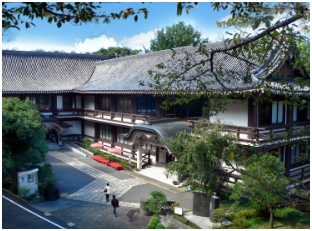

The Ryozen Foundation (to honor the Meiji Restoration patriots) established
The Ryozen Foundation was established in 1968, the 100th anniversary of the Meiji Restoration, with the purpose of preserving and maintaining the historical climate of Mount Ryozen of Kyoto’s Higashiyama district, a sacred mountain that has ties to the Restoration patriots and had since fallen into disrepair, and to pass on and promote Japan’s traditional spiritual culture. In 1970, the Ryozen Museum of History was opened in Kyoto as a museum dedicated to the comprehensive study of Japan’s history from the end of the Edo Period through the beginning of the Meiji Restoration. The museum collects, researches, and exhibits calligraphy, personal items, letters, and various materials and documents that once belonged to warriors, feudal lords, the Emperor, and the court nobility from that era, as well as writers, painters, and other artists that were active in the final days of the Shogunate.
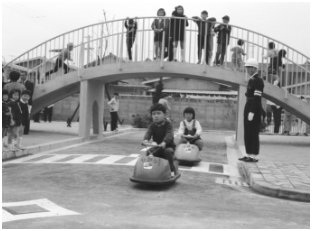

Donation of “Children’s Traffic Accident Prevention Fund” to commemorate our 50th anniversary
In 1968, to commemorate the 50th anniversary of Matsushita Electric’s founding, a total of 5 billion yen over 15 years was donated to prefectures and 6 ordinance-designated cities throughout Japan with the aim of protecting children from traffic accidents, which were increasing dramatically at the time. These funds were used to improve facilities such as children’s traffic parks, traffic safety education centers, and pedestrian bridges, as well as traffic safety education materials throughout Japan.


“Social Affairs Headquarters” dedicated to social contribution established
The “Social Affairs Headquarters” was established as a department dedicated to the company’s efforts to contribute to society. (present-day Corporate citizenship activities department )


Construction/donation of the Kaminarimon Gate and large lantern at Kinryuzan Sensoji Temple
The Kaminarimon Gate of Sensoji Temple in Asakusa, Tokyo, which had long been a temporary structure put in place following a fire that destroyed the previous one back in 1865, was restored and donated in 1960, ending a 95-year-long absence. Additionally, the Kaminarimon lantern at the center of the gate was also dedicated to the temple, and in 1978 the two statues on either side were donated as well. In 1982, 1992, and 2003, when the large paper lantern that has become the symbol of Asakusa was severely damaged, it was restored and dedicated once more.


Support of the Japan Kogei Association
Our founder Konosuke Matsushita had a deep interest in traditional Japanese crafts, which can be seen as “the starting point of manufacturing”.
In 1960, he began his support of the Japan Kogei Association with the hope of passing on and further developing these crafts, and he also became the first head of the Kinki Branch. Since 1979, we have given the "Konosuke Matsushita Award" (later renamed the "Panasonic Award") to artists from the Kinki region who have either won or been newly selected at the Japan Traditional Kogei Exhibition. Starting in 2024, the award was renamed the "Konosuke Matsushita Memorial Panasonic Award," with some changes to its content. In addition to the traditional award given to newly selected artists from the Kinki region at the Japan Traditional Kogei Exhibition, we have established two new awards: the "Kinki Exhibition Newcomer Award" and the "Kinki Branch Achievement Award," to honor and celebrate the achievements and contributions of Kinki branch members.


Donation of the “Umeda New Pedestrian Bridge” in front of Osaka Station
In 1964, we built what was at the time the largest pedestrian bridge in Japan, spanning the wide road between the plaza in front of Osaka Station and both the Hankyu and Hanshin buildings, and donated it to the City of Osaka. Completion of this pedestrian bridge eased automobile congestion and allowed pedestrians to cross the street safely, and is still used by many people today.


Began offering tours of our dry-cell battery plant (Moriguchi City, Osaka) for elementary and junior high school students
Around 1962, Matsushita Electric began a company-wide effort to encourage factories to offer tours, and was particularly proactive in developing a tour for its dry-cell battery plant. Many school groups use this tour not only as part of their science and social studies classes, but also as a destination on their school excursions.


The Ryozen Foundation (to honor the Meiji Restoration patriots) established
The Ryozen Foundation was established in 1968, the 100th anniversary of the Meiji Restoration, with the purpose of preserving and maintaining the historical climate of Mount Ryozen of Kyoto’s Higashiyama district, a sacred mountain that has ties to the Restoration patriots and had since fallen into disrepair, and to pass on and promote Japan’s traditional spiritual culture. In 1970, the Ryozen Museum of History was opened in Kyoto as a museum dedicated to the comprehensive study of Japan’s history from the end of the Edo Period through the beginning of the Meiji Restoration. The museum collects, researches, and exhibits calligraphy, personal items, letters, and various materials and documents that once belonged to warriors, feudal lords, the Emperor, and the court nobility from that era, as well as writers, painters, and other artists that were active in the final days of the Shogunate.


Donation of “Children’s Traffic Accident Prevention Fund” to commemorate our 50th anniversary
In 1968, to commemorate the 50th anniversary of Matsushita Electric’s founding, a total of 5 billion yen over 15 years was donated to prefectures and 6 ordinance-designated cities throughout Japan with the aim of protecting children from traffic accidents, which were increasing dramatically at the time. These funds were used to improve facilities such as children’s traffic parks, traffic safety education centers, and pedestrian bridges, as well as traffic safety education materials throughout Japan.


“Social Affairs Headquarters” dedicated to social contribution established
The “Social Affairs Headquarters” was established as a department dedicated to the company’s efforts to contribute to society. (present-day Corporate Citizenship Activities Department)
